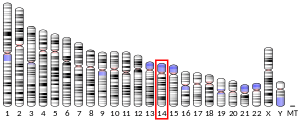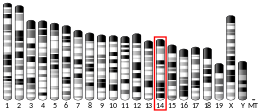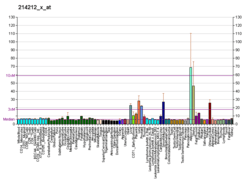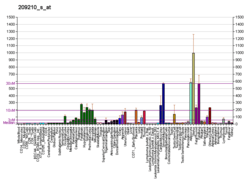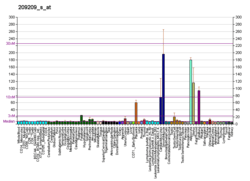FERMT2
Fermitin family homolog 2 (FERMT2) also known as pleckstrin homology domain-containing family C member 1 (PLEKHC1) or kindlin-2 is a protein that in humans is encoded by the FERMT2 gene.[5][6][7]
Kindlin-2 is the first of the kindlin protein to be discovered in 1994. It was detected in a screen for epidermal growth factor (EGF)-induced mRNAs and initially named mitogen-inducible gene 2 (Mig-2) protein.[5]
Function
FERMT2 is a component of extracellular matrix structures in mammalian cells and is required for proper control of cell shape change.[8]
A major task of kindlins is to regulate the activation of integrins.[9]
Role in health and diseases
- Loss of kindlin-2 in mice leads to peri-implantation lethality.[10]
- Kindlin-2 is highly expressed in activated myofibroblasts for regulation of focal adhesion formation.[11]
- Deletion of Kindlin-2 retards insulin secretion and reduces β-cell mass in mice.[12]
- Elevated kindlin-2 expression was observed in tubular intestinal fibrosis of the kidney, a condition is characterized by massive expansion of the cortical interstitium, conversion of fibroblasts into myofibroblasts and progressive EMT of tubular epithelial cells.[13]
- Kindlin-2 is required for angiogenesis and blood vessel homeostasis.[14]
- Kindlin-2 can exert tumor-promoting or tumor-inhibiting functions based on tumor-type-dependent.[15]
gollark: Hmm.
gollark: <@!293066066605768714> Is Toki Pona machine parseable?
gollark: That doesn't mean it wasn't *picked* for memetic reasons by GTech™ apiologists.
gollark: Applied memetics.
gollark: Rewrite HTML in HTML.
References
- GRCh38: Ensembl release 89: ENSG00000073712 - Ensembl, May 2017
- GRCm38: Ensembl release 89: ENSMUSG00000037712 - Ensembl, May 2017
- "Human PubMed Reference:". National Center for Biotechnology Information, U.S. National Library of Medicine.
- "Mouse PubMed Reference:". National Center for Biotechnology Information, U.S. National Library of Medicine.
- Wick M, Bürger C, Brüsselbach S, Lucibello FC, Müller R (January 1994). "Identification of serum-inducible genes: different patterns of gene regulation during G0-->S and G1-->S progression". Journal of Cell Science. 107 ( Pt 1) (1): 227–39. PMID 8175911.
- Weinstein EJ, Bourner M, Head R, Zakeri H, Bauer C, Mazzarella R (April 2003). "URP1: a member of a novel family of PH and FERM domain-containing membrane-associated proteins is significantly over-expressed in lung and colon carcinomas". Biochimica et Biophysica Acta (BBA) - Molecular Basis of Disease. 1637 (3): 207–16. doi:10.1016/S0925-4439(03)00035-8. PMID 12697302.
- "Entrez Gene: FERMT2".
- Tu Y, Wu S, Shi X, Chen K, Wu C (April 2003). "Migfilin and Mig-2 link focal adhesions to filamin and the actin cytoskeleton and function in cell shape modulation". Cell. 113 (1): 37–47. doi:10.1016/S0092-8674(03)00163-6. PMID 12679033.
- Rognoni E, Ruppert R, Fässler R (January 2016). "The kindlin family: functions, signaling properties and implications for human disease". Journal of Cell Science. 129 (1): 17–27. doi:10.1242/jcs.161190. PMID 26729028.
- Montanez E, Ussar S, Schifferer M, Bösl M, Zent R, Moser M, Fässler R (May 2008). "Kindlin-2 controls bidirectional signaling of integrins". Genes & Development. 22 (10): 1325–30. doi:10.1101/gad.469408. PMC 2377186. PMID 18483218.
- He Y, Esser P, Schacht V, Bruckner-Tuderman L, Has C (January 2011). "Role of kindlin-2 in fibroblast functions: implications for wound healing". The Journal of Investigative Dermatology. 131 (1): 245–56. doi:10.1038/jid.2010.273. PMID 20861856.
- Zhu K, Lai Y, Cao H, Bai X, Liu C, Yan Q, et al. (January 2020). "Kindlin-2 modulates MafA and β-catenin expression to regulate β-cell function and mass in mice". Nature Communications. 11 (1): 484. doi:10.1038/s41467-019-14186-y. PMC 6981167. PMID 31980627.
- Bielesz B, Sirin Y, Si H, Niranjan T, Gruenwald A, Ahn S, Kato H, Pullman J, Gessler M, Haase VH, Susztak K (November 2010). "Epithelial Notch signaling regulates interstitial fibrosis development in the kidneys of mice and humans". The Journal of Clinical Investigation. 120 (11): 4040–54. doi:10.1172/JCI43025. PMC 2964979. PMID 20978353.
- Pluskota E, Dowling JJ, Gordon N, Golden JA, Szpak D, West XZ, Nestor C, Ma YQ, Bialkowska K, Byzova T, Plow EF (May 2011). "The integrin coactivator kindlin-2 plays a critical role in angiogenesis in mice and zebrafish". Blood. 117 (18): 4978–87. doi:10.1182/blood-2010-11-321182. PMC 3100704. PMID 21378273.
- Zhan J, Zhang H (May 2018). "Kindlins: Roles in development and cancer progression". The International Journal of Biochemistry & Cell Biology. 98: 93–103. doi:10.1016/j.biocel.2018.03.008. PMID 29544897.
Further reading
- Kato K, Shiozawa T, Mitsushita J, Toda A, Horiuchi A, Nikaido T, Fujii S, Konishi I (January 2004). "Expression of the mitogen-inducible gene-2 (mig-2) is elevated in human uterine leiomyomas but not in leiomyosarcomas". Human Pathology. 35 (1): 55–60. doi:10.1016/j.humpath.2003.08.019. PMID 14745725.
- Olsen JV, Blagoev B, Gnad F, Macek B, Kumar C, Mortensen P, Mann M (November 2006). "Global, in vivo, and site-specific phosphorylation dynamics in signaling networks". Cell. 127 (3): 635–48. doi:10.1016/j.cell.2006.09.026. PMID 17081983.
- Wang L, Deng W, Shi T, Ma D (April 2008). "URP2SF, a FERM and PH domain containing protein, regulates NF-kappaB and apoptosis". Biochemical and Biophysical Research Communications. 368 (4): 899–906. doi:10.1016/j.bbrc.2008.02.024. PMID 18280249.</ref>
External links
- FERMT2 Info with links in the Cell Migration Gateway
This article is issued from Wikipedia. The text is licensed under Creative Commons - Attribution - Sharealike. Additional terms may apply for the media files.
